Lesson Four - How Can I Improve My Woodlot
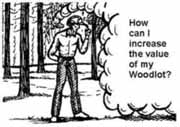 A woodlot is a dynamic asset that can be managed to increase in value. Woodlots include the bare land and the resources located under and on top of the bare land. It is difficult to improve the bare land value of our woodlots; however, we know the value of bare land, will continue to slowly increase.
A woodlot is a dynamic asset that can be managed to increase in value. Woodlots include the bare land and the resources located under and on top of the bare land. It is difficult to improve the bare land value of our woodlots; however, we know the value of bare land, will continue to slowly increase.
Woodlot owners can make improvements to the resources on their woodlot and increase the value of their woodlots. Below is a list of improvements that will be discussed in this chapter:
- boundary line maintenance and roads
- harvesting. thinning
- planting trees
- locating mineral deposits
- improving wildlife populations
- improving recreational opportunities
- identifying specialty markets for woodlot products.
BOUNDARY LINES
Although establishing boundary lines can be expensive, it is money well spent. You'll know exactly what you own!
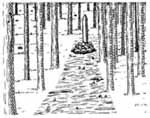 |
|
Figure 23.
Well-maintained boundary lines can add value to a woodlot. |
Your property will also be more marketable should you decide to sell it. As well, with the lines cut out and marked, you can manage it from boundary to boundary without wondering if you are on your neighbour's land. Generally, a woodlot will increase in value by the amount you have invested in your boundary lines. There are also cases where landowners, after establishing the property lines, found they owned more acreage than initially suspected.
Well maintained boundary lines also improve both the recreational and wildlife resources on the woodlot. The lines can be used as a hiking trails by people, or by wildlife as travel ways and edge.
Boundary Line Renewal
If enough evidence exists to know the exact location of your boundary lines you will be able to upgrade the boundary line. This is done by cleaning it out and applying fresh paint on the old blazes, which is less expensive than hiring a surveyor to establish a new line. When upgrading an old line do not destroy the old evidence.
If a new blaze is required, it should be placed above the old blaze, which should not be disturbed. If a new corner post is required, make sure the new post is placed in exactly the same location as the old one. Lay the old post beside the newly erected post, before renewing a boundary line, a licensed surveyor should be contacted for an opinion on the evidence that will be used to renew a line.
Boundary Line Survey
If evidence of a line cannot be found a survey should be carried out to locate the line. The only people authorized to carry out land surveys in Nova Scotia are registered Nova Scotia Land Surveyors. The names of all Nova Scotia Land Surveyors can be obtained by contacting the Association of Nova Scotia Land Surveyors, 159 Portland Street, Suite 301, Dartmouth, NS, B2Y 1H9.
Once boundary lines are established, they should be maintained every ten years or so to ensure that surveying will not become necessary again.
ROADS
 |
 |
|
Figure 24
A). A well maintained road allows easy travel. |
B). A poorly maintained road causes lots of frustration.
|
After establishing where your property is located, you may need to improve access. A road network will help you extract forest products and make the woodlot more accessible to yourself or the public. The cost depends on terrain, length, quality or grade of road, proximity to topping (such as shale, and gravel), and type of machinery available in the area. As with boundary lines, properly constructed and maintained road systems will increase the recreational potential allowing access with snowmobiles, all terrain vehicles, or a place to easily travel by foot. It also increases the edge and travel ways for wildlife, and increases the timber value because of lower extraction costs.
PROPER HARVESTING
Harvesting the timber from your woodlot should decrease the value of your woodlot. After all you are removing the timber value and some of the wildlife and recreational value. On the surface this sounds correct; however, as we look a little closer we see how proper harvesting can increase the value of your woodlot.
Sometimes we are forced to remove the timber from our woodlots because of insects, disease or age. In these cases, not only do we not have time to schedule the harvest properly, we do not have options as to how the harvest is completed. Generally we have to clear-cut, which decreases the timber value of the woodlot and maybe other resources a swell. However, if a woodlot is not over mature and is made up of wind firm, long-lived species (such as red spruce, eastern hemlock, white pine, sugar maple, yellow birch, and white ash), several harvest options are available to us (Refer to Module 2) We can harvest the mature to over mature growing stock in a series of partial harvests. (e.g. shelterwood cuts, selection cuts and patch clearcuts). These methods of harvesting allow removal of the mature and over mature growing stock leaving the younger more vibrant trees behind. Growth is concentrated on fewer remaining trees, thus increasing the size of the trees in the stand.
Increasing the size of the trees will increase the timber value of your woodlot.
In addition to increasing the size of the trees, partial cuts encourage natural regeneration of shade tolerant species. Partial cuts can also improve the recreational value of the property, shelterwood cuts improve how the woodlot looks while patch clearcuts create forest openings and edge for wildlife.
Although the cost of partial cuts can be higher than conventional clearcuts, the long term benefits of higher quality trees, shade tolerant natural regeneration, and increase in recreation and wildlife potential will balance the loss in revenues at the time of harvest.
Below is a table that compares the relative cost of harvesting with regeneration establishment.
Table 2. Summary of harvesting methods and relative costs of harvesting and reforestation.
UNEVEN-AGED STANDS
| Harvesting System | Harvesting Costs | Reforestation costs |
| Selection cut | Harvesting Costs are high. | Reforestation costs are low. |
| Clear-cut | Not applicable* | |
| Shelterwood | Not applicable* | |
| Seed tree | Not applicable* |
EVEN-AGED STANDS
| Harvesting System | Harvesting Costs | Reforestation costs |
| Selection cut | Not generally applicable | |
| Clear-cut | Harvesting costs are low. | Reforestation costs can be high. |
| Shelterwood | Harvesting costs are medium. | Reforestation costs are medium. |
| Seed tree | Harvesting costs are low. | Reforestation costs are medium. |
* Will not maintain uneven-age stands. Will create even-aged stands.
As you can see, determining the age structure of the stands in your woodlot will help you use the above table to choose a harvest method that meets your financial objectives. To improve your woodlot through harvesting, appropriate harvesting methods must be used (See module 2).
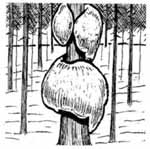 |
|
Figure 25.
A burl on a tree can be cut off and sold to a wood turner |
Markets
Locating markets for forest products harvested from your woodlot may require some effort and time. However, time may reveal a niche market that will offer a better for some of your forest products than traditional markets. Remember, an increase in price for your forest products will increase your bottom line. If the high end market is stable, it will increase the value of your standing timber which increases the value of your woodlot.
Examples of markets that increase the value of your woodlot would be veneer markets, and markets which can use defective trees for bowls and other things.
Utilization
Utilizing the tree by extracting all the forest products will increase the amount of revenue from a harvested tree. The harvested area will also be free of unsightly large tops of trees and trees partly limbed up. The area will be more aesthetically pleasing and may increase recreational activities such as walking and snowmobiling.
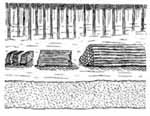 |
|
Figure 26.
Good utilization of a harvested tree will increase the value of your woodlot. |
Wildlife Guidelines
By following the Forestry/ Wildlife guidelines, wildlife populations will be sustained or enhanced, water courses will be protected and erosion will be minimized. For example, in a clearcut operation, protecting a stream by leaving a green belt along the stream will maintain the fish population and increase the edge on the property which may increase the population of deer, rabbits, foxes and other wildlife. Improving the wildlife habitat will increase the potential for hunting or fishing, or activities involving viewing or listening to wildlife.
Proper Equipment
Harvesting forest products requires equipment to extract the products or to cut and process the wood. Although some of the equipment is light, most of it is heavy enough to damage the soil if not properly used. Avoid harvesting during wet times of the year and use equipment with wide tires or tracks to prevent damage to soil and roads, which can be expensive to repair. Using the proper equipment can decrease the cost of reforestation and improve the aesthetics of the harvested areas. If wide tired forwarders use different extraction trails as they extract the forest products, the machines will crush the debris and slash that is generated during the harvest. This extraction technique will eliminate the need for site preparation if planting is required, will make the job look tidy, and will make it easy to walk the woodlot.
 |
|
Figure 27.
Skidder preparing site for planting while hauling wood from harvest operation. |
SILVICULTURE INVESTMENTS
Growing trees makes good sense. It will ensure that there is a forest for generations to come. Better still, using silviculture techniques will increase wood production and improve the value of our woodlots.
Planting or thinning can be expensive. Consideration should also be given to the return on your investment. You can spend a lot of money on a treatment for your woodlot and not get a return on your investment. However, with careful planning you can get a good return on a silviculture investment.
Table 3. Approximate 1997 costs of silviculture techniques used in Nova Scotia. Costs would be less for those who do their own work.
|
Plantations
|
||
|
Site Preparation
|
Preparing the site for seedlings
|
$0-180/hectare
|
|
Stock Acquisition
|
Producing improved seedlings
|
$275/hectare
|
|
Planting
|
Planting improved growing stock
|
$270/hectare
|
|
Weeding
|
Suppressing competing vegetation in plantations
|
$250/hectare
|
|
Thinning
|
Removing merchantable volume from stand to
|
$400/hectare
|
|
encourage diameter growth on remaining stems
|
|
|
|
Natural Stands
|
||
|
Pre Commercial
|
Thinning out unmerchantable stems (height 2-6 meters)
|
$800/hectare
|
|
Weeding
|
Suppressing competing vegetation in natural stands
|
$250/hectare
|
|
Thinning
|
Removing merchantable volume from stand to encourage diameter growth on remaining stems.
|
$400/hectare
|
Does Silviculture Pay?
This is a difficult question to answer. It depends on many variables such as silviculture costs, prices of wood products and other resources, and productivity of the land. However, the question "Can we increase the growth of our forest by using silviculture techniques?" can be answered "Yes!". On average we can double the growth of a forest with intensive silviculture. Also we can change the species of stands to longer-lived species which gives us more management options in the future. Longer-lived species lend themselves to partial cutting over clear cutting.
To see the financial impact a silviculture investment will create, use the following assumptions for the exercise on the next page.
Assumption #1
The price of forest products will increase at a rate of 5 per cent per year in the next 40 years.
Assumption #2
Price today for forest products is $6/m3 after harvesting costs (stumpage).
Assumption #3
Using the information presented in Table 1 regarding the increased growth rate using silviculture, we are able to generate the future worth of a stand that is treated versus one that is not.
No Silviculture
5 m3/ha/year x 40 years = 200 m3/ha
Intensive Silviculture
10 m3/ha/year x 40 years = 400 ms/ha
Calculation of Money Invested in Silviculture
Using values from Table III, it can be calculated that the cost to artificially regenerate area is as follows:
| Site Preparation | $ 180/ha | |
| Planting | $ 270/ha | |
| Stock | $ 275/ha | |
| Weeding | $ 250/ha | |
| TOTAL COST | $ 975/ha | |
Looking at our investment in 40 years, we would make the following calculations.
Price of Forest Products in 40 years.
$6/m3 at year 0 is increased at 5 percent per year for the next 40 years equals $42.2/m3 at year 40.
Value of Forest Products in Stand per hectare:
No Silviculture
$42.2/m3 x 200 m3 = $8,440
Intensive Silvicuture
$42.2/m3 x 400 m3 = $16,880
However, because the trees are large in the treated stand, lets assume an increase of 50 percent for quality $16,880 x 1.50 = $25,320.
The difference doing the intensive silviculture generate $16,880 (25,320 - 8,440) more value for the product per hectare. This suggest that we should do silviculture work; however, remember we invested $975 per hectare 40 years ago. If we invested that same $975 in a financial institution at rate of 6 per cent compounded annually for 40 years, we would receive $ 10,028.
From this simple calculation, you should invest money in intensive silviculture.
This is a simplified version of calculating growth to show the relationship of investment, growth and return. The results would change if the assumptions were changed.
It is fun to work through different assumptions, for instance changing the interest rate to ten per cent on the $975 invested in a financial institution, would perhaps dissuade you from investing in silviculture.
Grants of Incentives
The federal and provincial governments recognize the benefit for society of a healthy forest industry, especially in the form of taxation and a better environment. They also recognize that woodlot owners can not afford the total cost of doing intensive silviculture. In the last 25 years governments have cost shared silviculture programs with woodlot owners. Under these agreements, governments have reimbursed landowners up to 00% of the cost of silviculture treatments. Participating in these programs makes good economic sense for a woodlot owner. Using the above example, figure out your return if your cost was only 30 percent of $975. To sustain the forest resource into the future, it makes good economic sense for governments and industry to continue to participate in silviculture programs with woodlot owners.
OTHER PRODUCTS
In addition to fiber sales, woodlots have other products. Although developing these products are labor intensive and require some investment of capital, they can be financially rewarding if managed properly and also improve the value of your woodlot.
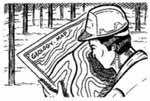 |
|
Figure 28.
With the assistance of a geologist you may find valuable resources below the forest floor. |
Mineral and Aggregate Deposits
As mentioned in Chapter 2, value on a woodlot can be found below the ground as well as above the ground. Woodlots can contain deposits of gravel, gypsum or other aggregates. By identifying such deposits and quantifying the amount, the value of the woodlot may increase significantly.
It may be necessary to hire a geologist to review topography and geology maps of the woodlot to identify deposits. He/she will also advise you as to the best procedure for testing the deposit.
Recreation and Wildlife Resource Potential
All woodlots in Nova Scotia have some recreation and wildlife potential. However, because some woodlots have greater potential than others.
 |
|
Figure 29.
Identifying recreational areas on your woodlot can increase its value. |
To identify the recreational potential on your woodlot, refer to Module 9. Investing in small structures such as camps, benches, foot the area of commercial outdoor recreation, see Woodlot Recreation Manual by Glynn Bissex (see additional reading).
 |
|
Figure 30.
Identifying recreational areas on your woodlot can increase its value. |
Christmas Tree Production
Most of the Christmas trees produced in Nova Scotia are balsam fir which originate from natural stands. Christmas tree markets tend to be cyclic, with the prices rising and falling according to supply and demand. It has been suggested that one person can efficiently manage 4 hectares of Christmas trees as a second job. Trying to manage more than 4 hectares requires additional labor and expense.
Maple Syrup
Only a limited number of the woodlots in Nova Scotia lend themselves to the production of maple syrup. Maple syrup comes from mostly sugar maple (Acer saccharum) and to a lesser extent Red maple (Acer rubrum). These species are usually found on well-drained, upland soils. To help sap collection, the stand should be located on a hillside so that sap can flow downhill to a catchment area, where an evaporator the water from sap and produce syrup. Otherwise a more time consuming method will be required. Equipment required for large scale maple syrup production is expensive. Some of the equipment includes taps and lines to collect the sap, a holding tank to store the sap, and an evaporator to evaporate the water from the sap. In addition, a camp has to be erected to house the evaporator.
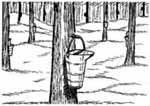 |
|
Figure 31.
Maple syrup production can generate extra income . |
Mushrooms
Mushrooms have traditionally been harvested in Europe and are a relatively new product for Nova Scotia forests. A popular variety call the chanterelle mushroom grows under mature white spruce stands. The conditions created on the forest floor under theses stands are ideal for the growth of the chanterelle mushroom.
Ginseng
Producing ginseng is new in Nova Scotia. Although ginseng grows naturally in Nova Scotia, it is difficult to locate. Ginseng can grow well under hardwood stands, which create the proper amount of sunlight for the plant. It requires more light in the spring and fall and shade in the direct sunlight of summer. This requirement is timed exactly with the production and loss of leaves in Nova Scotia's hardwood stands.
Although ginseng can require up to ten years to mature, it can yield good prices as a health product.
The NS Department of Natural Resources is growing ginseng seedlings at their Strathlorne Forest Nursery in Inverness as an experiment. If successful, it is hoped woodlot owners will plant the seedlings under their hardwood canopies. For more information, call The Strathlorne Forest Nursery at (902) 258-2626 or The Nova Scotia Agricultural College at (902) 258-2626.
Service Berry
The production of service berry (indian pear) may be a future crop for woodlots. Demand for the berry in Western Canada is increasing. Studies are presently being carried out in a cooperative venture between The Department of Natural resources and The Department of Agriculture and Marketing to determine what species of service berry can be grown in Nova Scotia. For more information call Strathlorne Forest Nursery at (902) 258-2626.
Blueberries
Although considered an agricultural crop, blueberries are grown on many woodlots in Nova Scotia. Blueberries can be found naturally on acidic forest soils. By properly managing competing vegetation, burning, stumping and leveling, a woodlot can produce blueberries in a relatively short time. Production of blueberries requires special equipment. Contact The Department of Agriculture and Marketing before proceeding.
In recent years, developed blueberry land has increased in value. At present, even undeveloped blueberry potential is getting increased prices.
Cranberries
Suitable locations for the production of cranberries are found in selected woodlots in Nova Scotia. Again, like blueberries, cranberries are considered an agricultural crop; however, they can be grown in a woodlot environment.
CERTIFICATION
A relatively new Marketing concept which may increase the value of the forest products for woodlot owners is the push for certification. Woodlot owners who have practiced sustainable forest management may get an increased price for their forest products which would increase the value of their woodlots.
Background
Most of the forest products produced in Nova Scotia are exported to other countries; two of the largest importers of Nova Scotia forest products are the United States and the European Community. In the past, Nova Scotia forest products were considered equal, whether they were produced from timber coming from forests that were properly managed or not.
Nova Scotia forest products that are exported are sold to large buying groups, who represent a large portion of the available market.
In recent years, in response to concern over the public's negative perception of forestry practices in Canada, the buying groups have been demanding that forest products being produced come from forests that are managed on a sustainable basis.
In the near future, it is possible to have two sets of forest sustainability standards in Canada, the Canadian Standards Association (CSA) and the Forest Stewardship Council (FSC), that would be recognized and desired by consumers abroad.
What does this mean to me as a woodlot owner?
At this point it is unclear exactly what it will mean to individual woodlot owners. It appears that a portion of Nova Scotia's traditional market will require certified forest products that come from sustainable forests. The certification process is elaborate and expensive. It is difficult t see how individual woodlot owners will be certified; however, it is quite conceivable woodlot owner groups rather than individuals could afford to be certified. If a group of woodlot owners were to become certified it may create a greater demand for individual woodlot owners' products.
At this point, it does not appear the buying groups are willing to pay a premium for certified products; however if the law of supply and demand come into play, and there are not enough certified products to supply the demand, the market may pay a premium to receive such a product.
If certification comes to be, an opportunity could be created for woodlot owners who manage their woodlots on a sustainable basis. Their forest products could be in demand, which may increase the value of the woodlot.